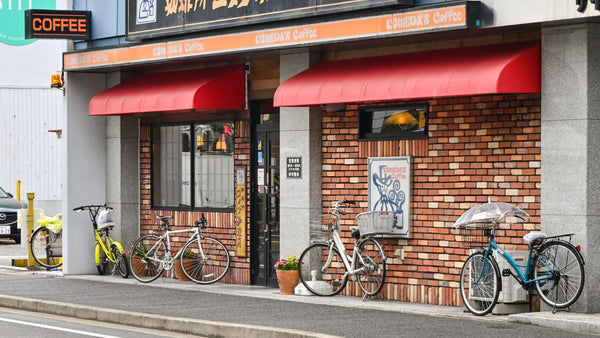
Jump to:
Japan has long been a key innovator in global coffee culture. Take the Hario V60. Its funnel design pushed pour-over coffee to new heights, while the Kalita Wave simplified home brewing. And flash-chilled coffee? It totally changed how we view iced coffee.
Key firsts include Kyoto-style cold drip brewing and 'sumiyaka' charcoal roasting. And UCC's canned coffee? You'll see those perky cans in every vending machine! Even a Japanese chemist, Satori Kato, made history in 1901 with a ground-breaking method for creating a stable, soluble coffee powder.
To help you navigate Japan’s coffee landscape, this guide will set apart the top coffee chains in Japan, you can learn simple phrases to order coffee in Japanese, and find out where to buy the best Japanese coffee online.
Coffee Culture in Japan
Coffee culture in Japan is currently in it’s ‘third wave’. This means a coffee landscape with recognizable brands, some offering espresso style drinks, alongside thriving artisanal cafés.
Third wave artisanal cafés are more likely to give you a choice of preferred bean or brewing style be it pour-over, siphon, French press, or manual espresso. You can engage in conversation about the coffee, even in broken English, at upfront counter bars, in cozy lounge setups, or trendy work spaces.
Artisanal coffee shops, however, are rarely found in prime locations that are usually dominated by any one or more of Japan’s ubiquitous coffee chains. Sometimes, however, you may still find a quaint traditional ‘Kissaten’ that has literally held its ground against all modern onslaughts.
10 Famous Japanese Coffee Chains
Around most major stations, along busy thoroughfares, in shopping complexes and arcades, you’re likely to come across any one of the major Japanese coffee brands. Sometimes you may have a convenient choice of coffee shops, but if not, it’s good to know what to expect.
Here is a run-down of 10 famous Japanese coffee chains, reviewed according to their nationwide store-count ranking:
-
Doutor Coffee: tasteful, refined, efficient
-
Mr. Donut: bottomless coffee, endless donuts
-
Komeda Coffee: comfy suburban coffee diner
-
Tully’s Coffee: your cozy neighborly hangout
-
St. Marco: best original pastries by far
-
Pronto: sophistication by day or by night
-
Hoshino: classic elegance with barista finesse
-
Café Veloce: great value for a shoe-string budget
-
Excelsior Caffé: where business and work gets done
-
Ueshima: a legendary coffee experience
1. Doutor Coffee

Doutor is the largest Japanese coffee chain with a market share of around 22 percent, compared to Starbucks (not a Japanese coffee chain) which is around 30 percent. Doutor, however, has shops in uptown and downtown locations, faded ‘shotengai’ arcades, and even inside stations.
Most shops have a similar set-up with moveable or fixed tables, and counters with built-in outlets for charging your devices. Spacing can be tight, and some shops still have enclosed smoking areas.
Doutor is famous for its no-fuss, fast and freshly made menu — especially its expanding range of Milano baguette sandwiches, but vegetarian options are still largely limited to dry toast with melted cheese. You can buy various fresh deserts, ready-to-go pastries, and they have an expansive range of drinks including a house blend, espresso options, soy milk and matcha favorites and even Rooibos tea.
Doutor is often crowed during peak times based on location, however, they tend to have a much faster turnover than Starbucks whose customers linger for longer. Doutor attracts busy people on the go, those looking for a quick breakfast or lunch, or leg-tired day-trippers. Their free Wi-Fi is easy to access and limited to 60 minutes.
2. Mr. Donut

Mr. Donut isn’t exactly a coffee chain, but it has some excellent coffee options and more donuts than you’ll ever need in a day! Plus, you’ll find a Mr. Donut as easily as you would a Doutor.
The atmosphere is more that of a fast food joint than a coffee shop. As much as you may love any number of donuts with your coffee, there are competing and mixed aromas from their dim-sum, ramen noodles, fried rice, and some shops even flog pizzas! They have a range of pies, mostly meat based, but also seafood and vegetarian options and a new snack line of ‘allergy-free’ and gluten-free snacks.
The best offer at Mr. Donut is their bottomless cup of black or milk coffee. Nowhere else will you get a free refill, but at some stores or franchises, the time period is limited or this Mr. Donut staple is sorely not available.
3. Komeda Coffee

Komeda Coffee has about 1000 outlets, located mostly in suburban areas. There are quite a few stores in and around central Osaka and Nagoya, and a few in upmarket and touristy Tokyo areas like Ginza, Chiyoda and Asakusa.
Komeda, with its distinctive brick facade with green awnings and signage, is your quintessential Japanese coffee house diner. They have a warm and nostalgic atmosphere, something between a Japanese kissaten and an American booth diner. More modern and refurbished stores are Wi-Fi friendly, with electrical outlets near to seating.
Komeda is the place to go for your typical Japanese cut-price, egg and toast ‘morning-set’ as well as their selection of hand-made sandwich salad sets. They also have an original dessert range, a kids' menu, decaf coffee and more.
Recently, the company opened a Komeda Is ‘plant-based kissa’ in Ginza. It has an extensive range of plant-based burgers, other vegan meal options, and gluten-free rice flour pancakes. If anything, it’s a unique first for Japan.
4. Tully’s Coffee

Although Tully’s still uses its original American brand name, Tully’s in Japan is a completely separate entity that is a Japanese owned and run coffee brand. It’s kind of like a low-key Starbucks, less crowded and with more dimmed lighting. This ‘neighborhood’ coffee shop attracts a lot of office workers, remote workers, bookworms, and people just needing a quiet and comfy place for as long as it takes.
Tully’s currently serves lunch-style spaghetti dishes, sandwiches and hot dogs, but there is very little on their menu, besides desserts or pastries, that may suit vegan preferences. They are known for their high quality coffee beans and top-notch espresso drinks. Their ‘coffee of the day’ features a unique bean selection every day, but you do not have a choice in the type of bean or roast in terms of ‘custom orders’.
5. St. Marco

St. Marco is a Japanese coffee chain with its own unique brand offering — their amazing ChocoCro stuffed croissants. The original ChocoCro had just plain chocolate slabs inside, but seasonal varieties often include banana, strawberry, milk tea flavor and a regular staple is matcha.
St. Marco serves other types of sweet and savory pastries, sandwiches, spaghetti, and special drink set offers. Their coffee selection is not so specialized with a typical choice of house blend, Americano, or Latte. Shops are often segmented into comfy lounge type areas, armchairs or casual seating at small tables, often a large table for keyboard warriors and quieter areas with counters and electrical outlets.
6. Pronto

Pronto, with its Sun and Moon logo, is a hip and cosmopolitan concept of a café by day and a ‘sakaba’ or tapas-style bar by night. By day, you can enjoy a typical Japanese morning set breakfast and light pasta dishes for lunch, alongside various take-away snacks. They have an excellent range of teas as well as original soft drinks.
Not every Pronto is a ‘sakaba’ by night, indicated by a green background to the sun and moon logo. Most ‘sakaba’ are in the Tokyo region, but there is one in Kyoto, Kobe, Takamatsu, and Kansai Airport.
Pronto actually has a number of brand concepts. Di Punto is a wine bar concept (currently only in Kanto, Nagano, and Kyushu) and E-Pronto a gastro-style café mostly found in Kanto with a couple of cafés in Osaka. Pronto is a Suntory Holdings company in collaboration with UCC Ueshima.
7. Hoshino

Hoshino (by Doutor) is probably the most upmarket coffee brand in Japan with its often dark wood paneling, plush leather-upholster booths, and armchair seating. The decorative elements typically evoke the charm and timeless feel of a traditional Japanese coffee house. Their focus is pour-over coffee, with signature offerings such as their souffle-style pancakes and French toast. They have a range of quality house made desserts, eggs and sausages for breakfast, comfort foods like gratins, omelette rice, toasted sandwiches and spaghetti. You often find their shops in business districts or department stores, and smaller cities tend to have only one outlet.
8. Café Veloce

Café Veloce is a Japanese coffee chain that isn’t trying to complete in terms of being slightly more relaxed, or slightly more upscale, or trying to attract the whole family crowd. Café Veloce is very affordable, unpretentious, and down-to-earth. It’s possibly the only coffee shop where you don’t pay a premium on snacks and where you can just opt for a simple peanut butter or jello sandwich. They also have simple egg, egg and tuna, potato salad and chicken sandwiches. Coffee is a basic choice between black drip coffee or latte espresso.
9. Excelsior Caffé

Excelsior Caffé, part of the Doutor group, has a modern, stylish, and generally spacious design. It aims to be a contemporary Italian-inspired café with menu items like panini sandwiches, risotto style ‘doria’, and spaghetti dishes. They pride the superior roast quality of their beans and freshness of their milk. Excelsior have the usual range of espresso-based drinks, and also beer on the menu. The vibe is low-key, accommodating people who want to study, work quietly, and not feel rushed to move on. Shops tend to be located on the ground floor of office blocks or in business districts. They have in-house Wi-Fi and ample seatings with electrical outlets.
10. Ueshima UCC

Ueshima Coffee House is the retail face of UCC, one of Japan’s biggest coffee industry leaders, founded in Kobe in 1933 by Tadao Ueshima. The company actually owns plantations in coffee producing regions, and imports premium beans directly to their stores. In deference to their historicity, their stores maintain a nostalgic ambiance with elegant dark wood, brass accents and classic seating — like a well-healed Kissaten but with modern comfort. Some stores use classic brewing techniques like nel net dripping. If you want bacon, eggs and toast for breakfast, Ueshima is pretty much the place to go, or try their Belgium waffles and toasted sandwiches if you prefer.
How to Order Coffee in Japanese: Phrases and Etiquette
Most coffee shops in Japan have an up-front order system at the service counter. Usually, they will have a picture menu for food and regular menu items. More upmarket cafés like Hoshino or diner style shops like Komeda will have a sit-down menu, where you pay afterward and not before.
1. Grab your seat BEFORE you order:

This may seem a bit upfront, pushy or unexpected for Japan, but there is no point in ordering sit-down if there is no table, and claiming a seat is your responsibility. The way to do this is to simply place a personal item like a glasses case, a book, a scarf, a bottle of water or a shopping bag at your spot. If the shop is busy, the staff may ask if you already have a seat. Just keep your ears pricked for the keyword ‘seki’ meaning ‘seat’. If you have no seat, the staff will ask you to wait while they do takeaway orders or orders for those with a seat.
-
Seki tottemasuka? (Have you got a seat?)
-
Seki atta! (I have a seat.)
-
Seki mada desu. (I don’t have a seat yet.)
-
Sho-sho matte kudasai. (Please wait.)
2. In-store or take-away

It’s often best to say upfront whether you're going to sit down or take out. The server may even ask you if you don’t say as in, “Ten-nai desu ka? (Is this to sit-down?)
-
ten-nai (dine in/sit down)
-
o-mochi kaeri (take away)
3. How to say your order in Japanese

All you need to do is to say the name of what you want followed by ‘~desu’ for neutral formal style, or ‘~chyodai’ in casual polite form or even ‘~onegai shimasu’ if you want to be super nice.
-
“Hotto ratte hitotsu desu” - Can I have one hot latte?”
If there is an order backlog or if your order will take longer than normal, the staff will give you a number place-holder for your table and say something like “O-seki made” meaning, “We’ll bring your order to your table”.
4. Nailing your Japanese coffee pronunciation
A lot of coffee words are reformulated into katakana Japanese, which can be very confusing! The word ‘hot’, for example, is pronounce ‘hot-to’ and if you miss the extra syllable, the server may not get what you are saying.
-
‘ko-hi’ = coffee
-
‘hot-to’ = hot
-
‘bu-ren-do’ = blend
-
‘ai-su’ = ice
-
‘rat-te’ = latte
-
‘mi-ru-ku’ = milk
-
‘e-ru’, ‘e-mu’, ‘e-su’ = L/large, M/medium, S/small
-
‘sai-zu’ = size as in ‘e-ru saizu’ or ‘large size’
The actual Japanese word for ‘hot’ is ‘atakai’ as in ‘atakai kohi’, if you need to clarify. Always double check orders for hot coffee in summer because most Japanese go for ice coffee and after taking 100 orders the server may start operating in default.
5. Remember to return your tray

A key etiquette in any upfront order system in Japan (including food courts) is to ALWAYS return your tray and table items to the used tray service window. It’s usually a little further on from where you order, but if not, look around and you’ll find it. Sometimes there is also a self-service cloth and alcohol spray to wipe your table, or just ask the staff:
-
“Ta-bu-ru o chotto fuite kudasai” (Could you please just wipe my table)
Where to Buy Authentic Japanese Coffee Online

One of the best places to buy coffee in Japan online is from the Ueshima UCC online store, and the online stores of other top Japanese coffee brands mentioned in this article. However, these Japanese online stores, including Ueshima, do not ship internationally.
If you want to try Japanese coffee for yourself and live abroad, you can easily order from Japanese Taste:
-
If you’re feeling nostalgic for Starbucks Japan, try our range of exclusive-to-Japan Starbucks drink mixes, including the Matcha Latte and the indulgent Creamy Cafe Latte.
-
Get your hands on UCC’s Gold Special ground blend or UCC’s premium drip coffee bags that conveniently hook over the edge of your cup for a no fuss pour-over experience.
-
For something truly unique, we recommend Doutor’s Au Lait Mochi marshmallow sweets.
-
Key Coffee sells a variety pack of pour-over drip bags with select roasts from Brazil, Colombia, and Mexico.
-
In the spirit of Japanese innovation, the Tsuki Usagi ceramic coffee dripper filters your coffee through porous holes without the need of filter paper.
To know more about tasty instant Japanese coffee, read our Brief Guide To Japanese Coffee Packets, which includes more top product recommendations.
Final Thoughts on Japan’s Unique Coffee Culture
Japanese people in general love their coffee chain stores. You know the value of what you’re getting, with the added convenience of familiarity. With over 10 Japanese coffee brands to choose from, each seems to have etched out its own specific niche. Not only that, they all compete with the merchandising of premium beans, pre-ground coffee, and other memorabilia.
At the other end of the deal, there’s high-quality coffee paraphernalia from unique filters, to gooseneck kettles, millers, and various brewing contraptions. Whatever your draw, you can also be guaranteed a good cup of coffee in Japan.
What are your favorite aspects of Japanese coffee culture? We’d love to hear them in the comments below.


0 comments